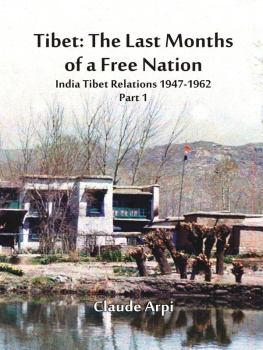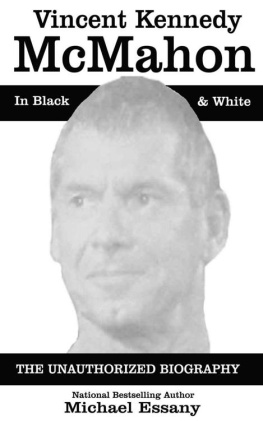Claude Arpi [Arpi - 1962 and the McMahon Line Saga
Here you can read online Claude Arpi [Arpi - 1962 and the McMahon Line Saga full text of the book (entire story) in english for free. Download pdf and epub, get meaning, cover and reviews about this ebook. year: 2013, publisher: Lancer Publishers LLC, genre: Romance novel. Description of the work, (preface) as well as reviews are available. Best literature library LitArk.com created for fans of good reading and offers a wide selection of genres:
Romance novel
Science fiction
Adventure
Detective
Science
History
Home and family
Prose
Art
Politics
Computer
Non-fiction
Religion
Business
Children
Humor
Choose a favorite category and find really read worthwhile books. Enjoy immersion in the world of imagination, feel the emotions of the characters or learn something new for yourself, make an fascinating discovery.

- Book:1962 and the McMahon Line Saga
- Author:
- Publisher:Lancer Publishers LLC
- Genre:
- Year:2013
- Rating:3 / 5
- Favourites:Add to favourites
- Your mark:
- 60
- 1
- 2
- 3
- 4
- 5
1962 and the McMahon Line Saga: summary, description and annotation
We offer to read an annotation, description, summary or preface (depends on what the author of the book "1962 and the McMahon Line Saga" wrote himself). If you haven't found the necessary information about the book — write in the comments, we will try to find it.
Claude Arpi [Arpi: author's other books
Who wrote 1962 and the McMahon Line Saga? Find out the surname, the name of the author of the book and a list of all author's works by series.
1962 and the McMahon Line Saga — read online for free the complete book (whole text) full work
Below is the text of the book, divided by pages. System saving the place of the last page read, allows you to conveniently read the book "1962 and the McMahon Line Saga" online for free, without having to search again every time where you left off. Put a bookmark, and you can go to the page where you finished reading at any time.
Font size:
Interval:
Bookmark:
1962
and the McMahon Line Saga
Claude Arpi


Published in the United States by
Lancer Publishers LLC
855 Peachtree St Suite 2602
Atlanta, GA 30308
under arrangement with Lancer Publishers & Distributors, New Delhi
(c) Claude Arpi, 2013
All rights reserved.
eISBN: 978-1-935501-57-2
www.lancerpublishers.us
Fifty years ago, India went through a tragic event which has remained a deep scar in the country's psyche: a border war with China.
During the author's archival peregrinations on the Himalayan border, he goes into some relatively little known issues, such as the checkered history of Tawang; the British India policy towards Tibet and even the possibility for India to militarily defend the Roof of the World.
The author also looks into why the Government still keeps the Henderson Brooks Report under wraps and what were Mao's motivations for 'teaching India a lesson'.
Throughout this series of essays, the thread remains the Tibet-India frontier in the North-East and the Indo-Chinese conflict.
The more one digs into this question, the more one discovers that the entire issue is intimately linked with the history of modern Tibet; particularly the status of the Roof of the World as a de facto independent nation.
British India had a Tibet Policy, Independent India, did not.
This led to the unfortunate events of 1962.
To Smiti, my daughter
The maps printed in this book are illustrative in character.
In some cases, they may not be fully accurate or exactly to scale.
They should however help the reader to follow the intricacies of the text.
The issue of the 1962 War and the India-China border dispute, so intimately linked with the status of Tibet, has pursued me for nearly forty years now, two-thirds of this present life.
If I had to express my gratitude to all those who have helped me during this exploration, it would take far too many pages.
Capt. Bharat Verma, my publisher, however needs a special mention. He offered to publish this book from his reputed publishing house without even having gone through the manuscript. Many may think that it is professional foolishness. But from my side, I can only express my gratitude for his constant trust.
I wish to thank him and his team for bringing this book out in time for the 50th anniversary of the Chinese attack in the NEFA and Ladakh. When he asked me "What is there to celebrate anyway", I could only answer that if, one day, we know better all the aspects of the issue, it might be easier to avoid the same mistakes. Maybe!
I want also to thank my favourite proof-readers, Deepti, my sister-in-law and my wife Abha who has not only been patient with me always (tough task indeed), but has also been a great source of inspiration. Both have tirelessly gone through the manuscript to make it more readable for an English speaking public.
In 2012, we are remembering the 50th anniversary of a tragic event which has remained a deep scar on the Indian psyche: the border war with China.
What makes the issue yet more painful perhaps is the fact that the Government of India (mostly under the Congress leadership since 1962) has continued to hide the report of the debacle prepared by Lt Gen. Henderson-Brooks and Brig. Prem Bhagat in 1963.
Why is the Indian public not authorized to know what happened on the slopes of the Thagla ridge of the then West Kameng division of the NEFA in October 1962?
It is one of the issues that we have tried to analyze from what is known of the famous Report. We have also gone through the probable reasons the present establishment has kept the report under wraps for nearly 50 years.
Our conclusion is that the local Army commanders (4 Infantry Division and 7 Infantry Brigade) were not told where the border was. A shameful Himalayan blunder indeed.
Several years ago, we acquired a large collection of British archival documents related to the Tibet-India border. For a long time we sat on it, but with the forthcoming 50 year (let us not call it 'Golden Jubilee,' though it could accurately be termed 'Black Jubilee'), we thought that we should do something with these rare documents. This is the genesis of these essays.
The thread that links this collection of papers is the Tibet-India (today China-India) frontier in the North-East, as well as other musings linked with the 1962 Sino-Indian conflict, for example Mao's motivations for 'teaching India a lesson.'
Despite hundreds of books and articles having been written on the 1962 China's war and the border issue, there is very little in print on the background of the War. Why did China go to war (though they say that it is India which attacked first)?
The more one digs into this question, the more one discovers that it is deeply, intimately linked with the history of modern Tibet, particularly the status of the Roof of the World as a de facto independent nation.
Nobody can deny that many contemporary issues in the domain of national security and defense are the direct outcome of what happened at the beginning of the 20th century on the Roof of the World and the tumultuous trilateral relations between British India, China and Tibet.
As World War II drew to a close, the position of the British government was clear. In August 1943, a note from Anthony Eden, the British Prime Minister; to Dr. T.V. Soong, the Chinese Ambassador in Great Britain says: "Since the Chinese Revolution of 1911, when Chinese forces were withdrawn from Tibet, Tibet has enjoyed de facto independence. She has ever since regarded herself as in practice completely autonomous and has opposed Chinese attempts to reassert control."
The dispute with China only started at the end of the 1950's as a consequence of China's occupation of Tibet. Relations between India and China today are closely linked to this event and a reading of these essays, will demonstrate that the border dispute with China will not be solved till the Tibetan issue is settled in a satisfactory way.
What also emerges from this study is that for centuries, if not millennia, there was no border in the Westphalian sense of the term; men and goods always travelled freely from one side of the Himalayan range to the other; this abruptly stopped in 1962.
It does not mean that there was no friction between the Tibetan world and the tribal populations living between the plains of Assam and the 'snow line,' as older British maps put it.
The border situation was undoubtedly hardened after the Chinese occupation of Tibet, especially after the Dalai Lama took refuge in India in March/April 1959. This also triggered a tougher stance by the Indian officials dealing with the border issue; first amongst them Jawaharlal Nehru, the Indian Prime Minister (as well as External Affairs Minister). The direct outcome was a war that India has neither forgotten nor really digested.
But before we go into the more contemporary period, it is necessary to have a look at the events of the beginning of the 20th century.
We start this series of studies with a young British Colonel, Francis Younghusband entering Lhasa with his troops in 1904.
In the Tibetan capital, Younghusband made a great discovery: the Chinese presence on the Tibetan plateau was a constitutional fiction.
This had long been suspected by British officials. After Younghusband's journey to Tibet, the British had concrete proof of it.
The Simla Conference in 1914 was the direct outcome of this discovery: if the Tibetan issue was to be solved, the Lhasa Government should be a party to any agreement.
Next pageFont size:
Interval:
Bookmark:
Similar books «1962 and the McMahon Line Saga»
Look at similar books to 1962 and the McMahon Line Saga. We have selected literature similar in name and meaning in the hope of providing readers with more options to find new, interesting, not yet read works.
Discussion, reviews of the book 1962 and the McMahon Line Saga and just readers' own opinions. Leave your comments, write what you think about the work, its meaning or the main characters. Specify what exactly you liked and what you didn't like, and why you think so.










